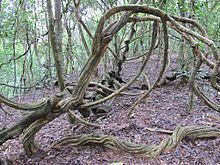 | ||
Representative species Common Grape Vine, Entada rheedii, Entada gigas, Bauhinia scandens, Muscadine grape | ||
Intro and importance of lianas on tree growth
A liana is any of various long-stemmed, woody vines that are rooted in the soil at ground level and use trees, as well as other means of vertical support, to climb up to the canopy to get access to well-lit areas of the forest. Lianas are characteristic of tropical moist deciduous forests (especially seasonal forests), but may be found in temperate rainforests. There are also temperate lianas, for example the members of the Clematis or Vitis (wild grape) genera. Lianas can form bridges amidst the forest canopy, providing arboreal animals with paths across the forest. These bridges can protect weaker trees from strong winds. Lianas compete with forest trees for sunlight, water and nutrients from the soil.
Contents

The term "liana" is not a taxonomic grouping, but rather a description of the way the plant grows – much like "tree" or "shrub". Lianas may be found in many different plant families. One way of distinguishing lianas from trees and shrubs is based on the stiffness, specifically, the Young's modulus of various parts of the stem. Trees and shrubs have young twigs and smaller branches which are quite flexible and older growth such as trunks and large branches which are stiffer. A liana often has stiff young growths and older, more flexible growth at the base of the stem.
Liana vs tree
Important genera
Described genera containing liana species include:
Gnetophyta
Acanthaceae
Ancistrocladaceae
Annonaceae
Apocynaceae
Arecaceae (Palmae)
Araceae
Aristolochiaceae
Bignoniaceae
Capparaceae
Connaraceae
Dilleniaceae
Dioscoreaceae
Fabaceae: perhaps not surprisingly, leguminous vines are well represented:
- Caesalpinioideae

- Faboideae (Papilionoideae)
- Mimosoideae
Flagellariaceae (order Poales)
Loganiaceae
Oleaceae
Polygalaceae
Sapindaceae
Rhamnaceae
Rubiaceae
Rutaceae
Schlegeliaceae
Smilacaceae
Vitaceae
Ecology
Lianas compete intensely with trees, greatly reducing tree growth and tree reproduction, greatly increasing tree mortality, preventing tree seedlings from establishing, and altering the course of regeneration in forests. Lianas also provide access routes in the forest canopy for many arboreal animals, including ants and many other invertebrates, lizards, rodents, sloths, monkeys, and lemurs. For example, in the Eastern tropical forests of Madagascar, many lemurs achieve higher mobility from the web of lianas draped amongst the vertical tree species. Many lemurs prefer trees with lianas for their roost sites. Lianas also provide support for trees when strong winds blow. However, they may be destructive in that when one tree falls, the connections made by the lianas may cause many other trees to fall.
As noted by Charles Darwin, because lianas are supported by other plants, they may conserve resources that other plants must allocate to the development of structure and use them instead for growth and reproduction. In general, lianas are detrimental to the trees that support them: growth rates are lower for trees with lianas, they directly damage hosts by mechanical abrasion and strangulation, render hosts more susceptible to ice and wind damage, and increase the probability that the host tree falls. Lianas also make the canopy of trees more accessible to animals which eat leaves. Because of these negative effects, trees which remain free of lianas are at an advantage; some species have evolved characteristics which help them avoid or shed lianas.
